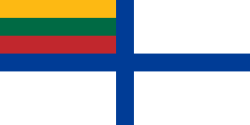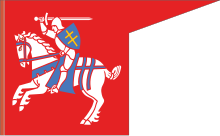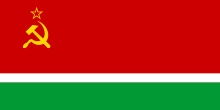Lithuanian flag
The Lithuanian flag is made up of three horizontal stripes of the same size: the upper one, yellow, symbolizes the wheat fields; the central one, green, symbolizes the forests, and the lower one, red, the color of the blood of those who died fighting for the homeland. The ratio between the width and the length of the flag is 3:5 (proportions were 1:2 until July 8, 2004).
The use by the Grand Duchy of Lithuania of a red banner with the figure of the "white knight" which appears on the shield during the battle of Grunwald (1410).
In traditional Lithuanian costumes, combinations of the colors yellow, green and white have prevailed, sometimes two and sometimes all of them. The debate about the composition of the Lithuanian flag began at the end of the XIX century and various versions began to be presented. The current design was drawn up by a commission consisting of Jonas Basanavičius, Tadas Daugirdas and Antanas Žmuidzinavičius, which had been appointed by the Lithuanian Provisional Government, after the disintegration of the Russian Empire in 1917. On April 25, 1918, the Lithuanian Council approved the design proposed by the commission. The flag was used until 1940, when the country was incorporated into the Soviet Union as the Lithuanian Soviet Socialist Republic.
On March 20, 1989, it was once again officially declared the flag of the Republic of Lithuania, although the colors that make it up are lighter than the original ones.
History
The oldest known Lithuanian flags are recorded in the 15th century manuscript Banderia Prutenorum, written by Jan Dlugosz. At the Battle of Grunwald (1410) two different flags were present. Most of the 40 regiments carried a banner depicting a knight pursuing an unseen enemy. This flag, known as the Vytis, would eventually come to be used as the Lithuanian war flag, and again in 2004 as the state flag. The rest of the regiments carried a banner showing the columns of Gediminas. Those carrying the Vytis, also known as the Pahonia, were troops from the Grand Duchy of Lithuania, while those carrying the Gediminas columns were from Lithuanian noble families. Until the end of the 18th century, when the Grand Duchy of Lithuania and the Lithuanian states annexed it to the Russian Empire. happened they used the Vytis as a flag.
The birth of yellow, green and red occurred during a campaign by other European republics to change their flags. One example that brought the idea of a tricolor flag to life was the flag of France adopted after the French Revolution. The only tricolor Lithuania had before the yellow, green and red was the green, white and red used to represent Lithuania Minor.
It is not known who originally suggested the use of yellow, green, and red, but the idea is often attributed to exiled Lithuanians living in Western Europe or the United States in the 19th century XIX. These three colors were often used in folk fabrics and national costumes. At the Vilnius Grand Assembly in 1905, this flag was preferred over the Vytis as the flag of the Lithuanian nation. The Vytis, of whom Jonas Basanavičius was a strong supporter, was not elected for three reasons: the first was that the Seimas (Lithuanian Parliament) wanted to distance itself somewhat from the flag of the Grand Duchy of Lithuania, which also comprised nations - today in independent days - such as Belarus and Ukraine. The second reason was the choice of the color red by revolutionaries who supported Marxist or communist causes. And finally, the flag with the Vytis would have been too complicated and not easily seen.
In 1917, during the Vilnius Conference, there were debates about the national flag. Two colors, green and red, were chosen for their predominance in folklore. The artist Antanas Žmuidzinavičius decorated the conference hall with green and red flags. However, the design was not liked by the delegates, who found it too dark and sad. Tadas Daugirdas then suggested adding a thin yellow stripe (symbolizing the rising sun) between the red (clouds illuminated by the morning sun) and green. (fields and forests). The delegates decided, however, that the issue should be dealt with by a special commission, composed of Basanavičius, Žmuidzinavičius and Daugirdas. On April 19, 1918, they sent the result to the Lithuanian Council. The flag was to be a tricolor (yellow above, green in the center, and red below) with the Vytis in the upper left or center corner. The Council accepted the proposal, but the 1922 Constitution did not include any mention of the coat of arms.. It adopted the national flag used today.
Discussions over the national flag continued; his opponents considered gold an inappropriate color, since the combination of yellow, green and red did not follow the rules of heraldry. However, no changes were made during the interwar period. Lithuania was annexed by the Soviet Union in 1940. During World War II Lithuania was occupied by Nazi Germany (1941-1945) and after the Nazi defeat it returned to form part of the Soviet Union. During the Soviet occupation period two flags were used. The first consisted of a red background with a gold hammer and sickle and the text LIETUVOS TSR (“LITHUANIAN SSR”) in gold on it. This flag was replaced in 1953 by the last flag used by the Lithuanian SSR: a red background with the hammer and sickle and a star next to the pole and two stripes, white and green, at the bottom. During 1988 As the Lithuanian independence movement gained strength, the Lithuanian Supreme Soviet again recognized the tricolor as the national flag, formally defining the colors a year later, and replacing this flag with that of Soviet Lithuania. After independence from the Soviet Union, the tricolor was outlined in the new Lithuanian Constitution and adopted in a referendum in 1992.
Design and symbolism
Passed on June 26, 1991, the Law of the Republic of Lithuania on the Lithuanian State Flag governs the design, sizes and use of the Lithuanian national flag. The law was last amended on July 8, 2004, with the most notable changes being the change in the proportions of the flag from 1:2 to 3:5 and the official adoption of a historic flag as a state or government flag. The amendment entered into force on September 1, 2004, after approval by President Valdas Adamkus.
The correct colors of both the national and state flags were made according to the Pantone Matching System. The ratio of both the national and state flags should be 3:5, with the standard size set at 1 meter by 1.7 metres. Different sizes of the flag can be created, but its color and proportions must match those specified in the law.
The yellow on the flag symbolizes the golden fields of Lithuania, the green its green fields, and the red represents the blood shed by Lithuania. The official Pantone Colors were published in 2004; the list below shows the official colors and their equivalents:
| System | Yellow | Green | Red (Purgeon) |
|---|---|---|---|
| Pantone | 15-0955 TP / 1235 c/u | 19-6026 TP / 349 c/u | 19-1664 TP / 180 c/u |
| RGB | 253-185-19 | 0-106-68 | 193-39-45 |
| CMYK | 0-30-100-0 | 100-55-100-0 | 25-100-100-0 |
State flag (since 2004)
In 2004, along with the law authorizing the change of the proportions of the flag, a new state flag was adopted. This flag shows the national emblem and has the same proportions as the old national flag, 3:5. The state flag, called by law historical flag, was proposed by Česlovas Juršėnas, deputy spokesperson for the Seimas, and by Edmundas Rimša, chairman of the Heraldry Commission. This flag was proposed at the same time as the coat of arms; both were intended to commemorate the 750th anniversary of Mindaugas' coronation in 1253. The designer of the flag and coat of arms was Arvydas Každailis. Historically, this flag was used during the Battle of Grunwald, and served as the government flag of the Republic of Central Lithuania between 1922 and 1939. It was one of the few flag candidates for the national flag on the way to Lithuanian independence. It should also be noted that some other countries also have an official national flag for civilian use and a state flag for government use. Some of these countries are Finland, Spain[citation needed], Venezuela, Germany and Thailand.
According to the National Flag Law, the flag must be permanently flown in three places: the Royal Palace of Lithuania, the Castle on the island of Trakai and the Vytautas the Great War Museum in Kaunas. In addition, it must be hoisted:
- On 16 February, next to the House of Signatories, on Pilies de Vilna Street.
- On March 11th, next to the Palace of the Seimas.
- On July 6, next to the Presidential Palace of Vilna.
- On July 15: next to the Ministry of Defence in Vilna.
- On 25 October, next to the Seimas Building, the Presidential Palace and the 11th Avenue Gediminas de Vilna, which houses the Government of Lithuania.
Protocol
The flag can be flown vertically or horizontally on public buildings, private homes, businesses, boats, squares, or during official ceremonies. If the flag is hoisted horizontally, the yellow stripe must be at the top; if hoisted vertically, the yellow stripe must be on the left side. Although the flag should be flown from sunrise to sunset, Lithuanian government offices must fly it 24 hours a day. Flags must conform to legal standards, and may not be soiled or damaged in any way.
During the days of mourning, the flag may be raised in any of the following ways. The first method, commonly known as half-mast hoisting, occurs when the flag is fully hoisted and then lowered to one-third the length of the pole. The other method is to add a black ribbon to the flag. The ribbon is four inches wide and is attached to the flagpole in such a way that the ends of the ribbon reach the bottom of the flag. During funerals, the flag may be used to cover the coffins of government officials, soldiers, signers of the Declaration of Independence, and presidential appointees. These flags are later folded and presented to the other relatives before burial.
When the flag of Lithuania appears together with other flags, the correct order is as follows: the national flag, the historical (state) flag, flags of foreign states, the flag of the European Union, international NGOs, the presidential banner, military and government banners, county flags, city flags and any other flag. When foreign flags are used alongside the Lithuanian flag, the flags are arranged according to the names of the countries in the Lithuanian language. The only exception occurs when the congress or meeting dictates a different language to be used in that ordination. The European Union flag has been used in Lithuania since it joined the Union. Although it is not mentioned by law, the NATO flag can be used in Lithuania, since the country also belongs to this organization. It is also common to fly the Estonian and Latvian flags on certain occasions, mainly during the celebration of the independence of the three Baltic countries. The Law of the Republic of Lithuania on the National Flag and Other Flags governs the standards, use, protocol and manufacture of the national and other flags used in the country.
Days of the National Flag
According to the protocol, the flag must be raised daily, but it is required by law on the following days:
| Day | Name | Notes |
|---|---|---|
| 1 January | Flag Day | It commemorates the day when the national flag was first placed in the Gediminas Tower in 1919. |
| 13 January | Patriot Day | In memory of the events of January 1991. |
| 16 February | Day of Restoration of the State of Lithuania (of the Russian Empire in 1918) | The flags of Latvia and Estonia are set up. |
| 24 February | Estonian Independence Day | The flags of Latvia and Estonia are set up. |
| 11 March | Lithuanian Independence Restitution Day (of the Soviet Union, in 1990) | The flags of Latvia and Estonia are set up. |
| 29 March | NATO Day | In commemoration of Lithuania ' s accession to the Atlantic Alliance in 2003; it is joined by the NATO flag. |
| 1 May | European Union Day | In honour of the entry of Lithuania into the European Union in 2004; it is joined by the flag of the European Union. |
| 9 May | Day of Europe | The end of the Second World War is commemorated (in 1945; known during the Soviet era as the Day of Victory. |
| 15 May | Day of Proclamation of the Assembly (Seimas in Lithuanian) Constituent | In honour of the Constituent Assembly of Lithuania. |
| 14 June | Day of Luto and Hope | Anniversary of the first massive deportations of Lithuanians to Siberia in 1941; it carries luto currency. |
| 15 June | Day of Occupation and Genocide | Anniversary of the Soviet occupation of Lithuania in 1940; it carries luto currency. |
| 6 July | Lithuanian Constitution Day in State | It commemorates the coronation of Mindaugas, the first king of Lithuania, in 1253. |
| 15 July | Day of the Battle of Grunwald | It commemorates the victory of Lithuanians and Poles over the Teutonic Knights in 1410. |
| 23 August | Black Lace Day | Anniversary of the signing of the Molotov-Ribbentrop Pact in 1939; it carries luto currency. |
| 31 August | Freedom Day | Anniversary of the Lithuanian Red Army march in 1993. |
| 23 September | Day of the Genocide of the Lithuanian Jews | Anniversary of the destruction of the ghetto of Vilnius by the Nazis in 1943. |
| 25 October | Constitutional Day | Anniversary of the adoption of the National Constitution in 1992. |
| 18 November | Independence Day of Latvia | It is mounted along with the flags of Latvia and Estonia. |
| 23 November | Day of the Lithuanian Soldier | Anniversary of the creation of the Lithuanian Army in 1918. |
Other Lithuanian Flags
Since 1992 a naval ensign has been used. The flag has a white background with a blue cross and the national flag in the canton. The width of each cross is 1/7 of the total of the flag, with a 1:2 ratio. Historically it was used by the Kaunas Yacht Club, but with a 2:3 ratio the bow flag consists of a field white with blue anchor covered by the Lithuanian naval ensign. The insignia is made up of the Columns of Gediminas in yellow on a red disc. The mast flag has been adopted by the Lithuanian Navy on their ships.
The Seimas officially assigned the President of Lithuania a banner in 1993. The banner is the State Coat of Arms of Lithuania centered on a monocolor background. According to the letter of the law the color is purple, but in practice it is dark red. The ratio of the banner is 1:1,2
Each province of Lithuania has adopted a flag following a common pattern: a blue rectangle with ten gold Vytis crosses, which frame the central element of the flag, chosen by each province. Most of its designs are adaptations of the coat of arms of the province itself.
Contenido relacionado
Aceuchi
Bolivian Politics
Cliometrics










